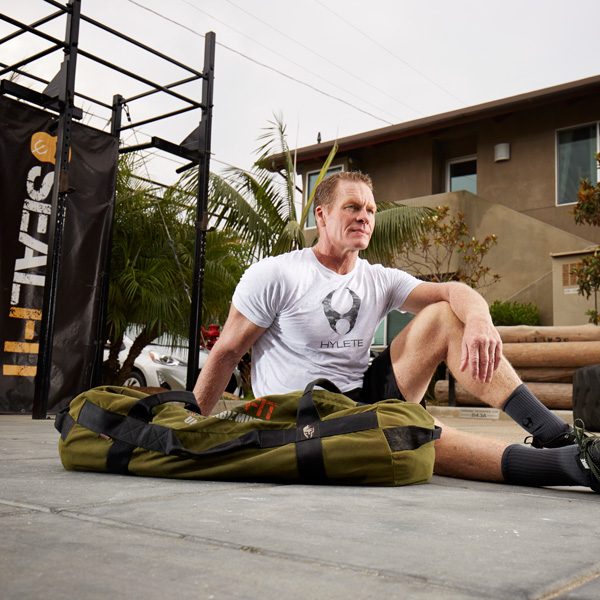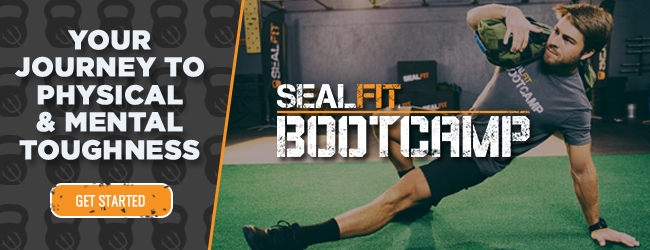When you see a high-level SEALFIT athlete in a training session or during a challenge event, one of the things that often surprises an outsider is how effortless they make it look. Of course, it’s anything but—applying a high level of mental control, stamina, work capacity and functional mobility through a heavy-duty grinder session takes that hard-charging athlete to the edge and beyond.
The reason it looks so fluid and controlled to the outsider is that the trained SEALFIT athlete has fully integrated the foundational principles of mental, emotional and intuitional development into the training. This allows them to self-induce a flow state. He or she is a master of the internal domain and it shows up as fluid, effortless movement in the outer domain. But in order to master the internal domain through SEALFIT training, the basics of the physical training itself must first be mastered.
One thing that is important to note is that WODs (workout of the days) are broken into three levels: On-Ramp, Basic Training, and Advanced Operator WODs, relying on the crawl, walk, and run approach to training we relied on in the SEAL Teams. In other words, in order to run, you have to be able to walk, and in order to walk, you have to be able to crawl.
Even the most athletically-advanced newcomers to SEALFIT will start at the beginning—with an On-Ramp training cycle or in our US CrossFit affiliate programmed workouts.
There are several reasons for this, but first, let’s reverse engineer that state of flow we see in the elite SEALFIT athlete.
10 Domains of Being Physically Fit
Someone who has been dedicated to the training program for many months or years has been systematically, on a daily and weekly basis, tasked with improving each of 10 domains of physical and mental fitness. Let’s go through what those 10 domains are.
Endurance
Endurance is the collective ability of the body’s systems to deliver oxygen to the working muscles. It all starts with breathing, getting air into the lungs, and oxygen into the blood. To improve your performance in distance running, swimming, cycling and rucking, your training needs to improve the efficiency of all the systems involved in cardiovascular endurance.
Stamina
Stamina and endurance are not the same things. Endurance is about processing oxygen; stamina is the ability of the body to process energy. Stamina is how long muscles can perform at maximum output before fatiguing. Anyone who has taken on one of our crucible challenges, like a 20X or Kokoro, knows how important stamina is. Building physical stamina is a step in cultivating more mental toughness as well.
Strength
Strength is the ability of muscles to apply force and overcome resistance. In SEALFIT training we seek relative strength in a manner that makes one able to carry adequate load for your frame, and to be an effective teammate (by hauling a wounded comrade out of a danger zone for instance). Strength can be benchmarked with 1 and 3 round max efforts in classic power lifts such as the deadlift, back squat, and bench press. Further, developing strength gives us greater confidence and mental focusing power.
Flexibility
We define flexibility as maximizing the range of motion of your muscles and mobility of your joints. If you can’t get below parallel in a squat, you may be missing range of motion not just in your hips and knees, but also in your ankles. Flexibility work is often overlooked or not considered as important. Our view is that to perform effectively over a lifetime at work and play, we must develop adequate flexibility and mobility. Flexibility allows us to run, jump, climb, lift, heave, pull and throw without springing a gasket and getting injured. It also leads to greater strength and stamina gains because we are able to recruit energy systemically. Warrior Yoga is our unique flexibility and mental training system that compliments SEALFIT WOD training.
Power
Power is defined in physics by the equation Power = Force x Velocity. It means how much weight you can move and how far you can move it. Power is developed when we move a load at increasing speeds, such as with Olympic lifting movements, like the snatch and clean-and-jerk. Moving weight from ground to overhead is a full body effort which requires significant power input.
Your power will be affected by strength, mobility, speed, agility and coordination. It is probably redundant to say that this type of ballistic power movement develops mental agility and focus, furthering our efforts toward integrated training.
Speed
Speed is the ability to minimize the time cycle of a repeated movement. Sprinting is an obvious example of speed. Speed is important to the SEALFIT athlete if we need to get to or away from the enemy fast. The “enemy” can be a crisis (imagine outrunning the Thai Tsunami) or a bad guy coming toward you. If you are a sports athlete speed training takes on a different hue. At any rate, speed work also builds durability – just note the different body types of an Olympic sprinter versus a marathon runner for proof.
Coordination
Coordination is defined by how well you take several movement patterns and align them into a distinct movement. The snatch is an excellent example of a movement that requires a high-level of coordination to do well and at your potential. Greater coordination means greater grace and less prone to injury.
Agility
Agility is the ability to minimize the transition time from one movement pattern to another. We are actively training agility when we perform movements like burpee-box jumps or burpee pull-ups. Shuttling gear between and over obstacles while dodging enemy shooters takes agility. Someone who has physical agility will tend to display mental agility as well – another indication of the tight integration of the mind-body system.
Balance
Balance is the ability to control placement of the body’s center of gravity in relationship to its support base. When an Olympic lifter is trying to secure a new PR, you’ll visually be able to see the importance of balance and counter-balance at work. Balance is often taken for granted, but, in fact, it’s crucial to everyday life.
Falls are a leading cause of death in unintentional injuries, according to the CDC. Balance can be trained, and does not come naturally to many non-natural athletes, something that we notice doing standing balancing poses in warrior yoga.
Accuracy
Accuracy is the ability to control movement in a given direction at given intensity. When you’re performing a gym exercise like wall balls—dropping into a front squat with a medicine ball in your hands and against your chest—then explode upward and thrust the ball toward a target above you on the wall—you’re putting into play your accuracy skills. As we learn to be more accurate with our external movements, we also refine the accuracy of our thinking.
Clearly there is overlap between these domains and when we train one, we are training a host of them. Also, from an SEALFIT Unbeatable Mind perspective, we leverage the physical skills to strengthen our mental skills, leading to the integrated performance of a trained SEALFIT athlete.
If the training program you’re currently utilizing fails to effectively incorporate each of the above domains of physical and mental development, then you are missing an opportunity to enhance your performance and gain control over your personal flow-activator. It could also open you to the risk of injury and those of you who are warrior or industrial athletes such as a firefighter, or police officer—that can be a matter of life and death.
Leave a Reply cancel reply
You must be logged in to post a comment.





No Comments